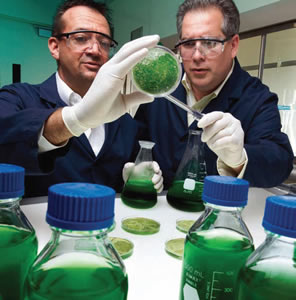Dateline 2030

In this special QSB Magazine interview, Dr. Hugh Helferty, Manager of Products Research and Technology with ExxonMobil, talks with Assistant Professor Gary Bissonette and shares insights on how global energy demands are being met today and how these will evolve in future, especially as new technologies emerge.
Gary Bissonette (GB): Concerns about emissions of carbon dioxide (CO2 – also known as a greenhouse gas) are resulting in increasing regulatory and social responsibility pressures on the energy sector. What are some of the initiatives that ExxonMobil has undertaken and is considering in response to these pressures?
Hugh Helferty (HH): The issue of greenhouse gas emissions has definitely attracted significant global attention in recent years. At ExxonMobil, we’ve concentrated our efforts in three major areas:
- Improving the efficiency of our existing operations;
- Improving efficiency in consumer use of fuels;
- Developing breakthrough technologies.
In the first case, ExxonMobil invested more than US$1.5 billion over the last six years to improve efficiency and reduce greenhouse gas emissions from our operating facilities, such as refineries and chemical plants. We have reduced greenhouse gas emissions in our operations by more than 7 million metric tons since 2005, which is the equivalent of taking about 1.4 million cars off the road. These investments are not just good for the environment, they’re good for profitability as they reduce the cost of our operations.
Our second approach involves developing products that enable customers to reduce their energy use and CO2 emissions. For example, we’ve developed specially formulated lubricants for cars, trucks and industrial equipment that help end-users reduce their energy consumption. We’ve created tire liners that retain air better than their predecessors, thereby improving vehicle fuel efficiency. Our plastics are used in a number of automotive components to reduce weight. We’re involved in joint research with auto and engine manufacturers on other efficiency technologies. And we have developed a technology to improve the separator films used in lithium-ion batteries, which are used in laptops, cell phones and, increasingly, hybrid vehicles. These films, produced and marketed by a joint venture in which ExxonMobil has a 25% interest, can stand up to the more demanding conditions these batteries face in vehicle applications.
 Biotech research to develop the raw material for transportation fuels from algae Our third approach relates to our participation in the development of breakthrough technologies. Here’s just one example: Over the next five years, ExxonMobil will spend up to US$600 million on a joint program with Synthetic Genomics Inc. to develop a strain of algae that can consume CO2 and, through a highly integrated production process, produce bio-oil and process it into a liquid biofuel you can use in your car. Consider the large amount of CO2 that a coal-fired power plant emits, and then imagine turning those emissions into a liquid fuel. The potential benefits of this are enormous. It’s a promising concept, but we have to develop it and demonstrate that it can be scaled up for commercial production. This approach should have significant advantages over conventional biofuels production. For instance, algae can be grown in environments not suited to growing food crops such as corn or soy, which are used today for biofuels.
Biotech research to develop the raw material for transportation fuels from algae Our third approach relates to our participation in the development of breakthrough technologies. Here’s just one example: Over the next five years, ExxonMobil will spend up to US$600 million on a joint program with Synthetic Genomics Inc. to develop a strain of algae that can consume CO2 and, through a highly integrated production process, produce bio-oil and process it into a liquid biofuel you can use in your car. Consider the large amount of CO2 that a coal-fired power plant emits, and then imagine turning those emissions into a liquid fuel. The potential benefits of this are enormous. It’s a promising concept, but we have to develop it and demonstrate that it can be scaled up for commercial production. This approach should have significant advantages over conventional biofuels production. For instance, algae can be grown in environments not suited to growing food crops such as corn or soy, which are used today for biofuels.
ExxonMobil has reduced greenhouse gas emissions in our operations by more than 7 million metric tons since 2005, which is the equivalent of taking about 1.4 million cars off the road.
GB: It is estimated that by 2030, CO2 emissions will have grown by another 25% and the global marketplace will be demanding 35% more energy than it is using today. How do we move to a more sustainable and less carbon-intensive future, given these anticipated energy needs?
HH: Let me offer three approaches that can help reduce CO2 emissions:
- Improving the efficiency of fuel and energy consumption;
- Using low/no carbon fuels for power generation;
- Using alternative energy sources such as wind and solar power.
The approach with the most immediate wide-ranging application involves improving the efficiency of energy and fuel consumption. One example is the continuing improvement in vehicle fuel economy. This can be achieved, in part, through the use of smaller vehicles which are already common in Europe, and through advances in vehicle technology. Another example that comes to mind is the use of compact fluorescent light bulbs instead of the decades-old incandescent bulb. The new energy-efficient bulbs consume about 75% less than their incandescent counterparts. These are just a few examples. There are many technologies in place today that improve our energy efficiency, and more are on the way. Increasing efficiency is equivalent to increasing supply, so it’s very important over the long term.
The second way we can make a significant impact on reducing emissions is by using less carbon-intensive energy sources where possible. For example, greenhouse gas emissions from natural gas-fired power plants are up to 60% lower than they are from coal plants. ExxonMobil is working to increase the supply of natural gas, including so-called unconventional natural gas. This includes gas trapped in shale that requires special technologies to extract. These technologies have recently become economic, which is why there’s so much interest and activity in shale gas right now.
Nuclear energy is another alternative to coal as a source of power generation and many proponents believe it is under-utilized in North America especially. More than 75% of the power used in France is generated from nuclear power. One might ask, “Why is this acceptable in France but not elsewhere?”
The third approach that can pay dividends in emission reductions is the use of lower-carbon alternatives such as next-generation biofuels or wind and solar energy. Growth in wind energy is especially strong and ExxonMobil contributes to this by being the world’s leading supplier of lubricants for wind turbines. This enables the turbines to continue to operate well, even in colder climates such as Canada’s.
Solar energy, although growing, still needs major advances in technology to improve efficiency. Without these advances, solar energy will generally be uneconomic for large, commercial applications.
Today, wind and solar energies meet less than 2% of global energy demand. Despite a strong growth rate from this small base, they will still make up less than 3% of energy supply by 2030. Given the anticipated 35% growth of energy demand already mentioned, we need to draw on whatever sources of energy are available and economic to help to meet that demand.
And, while alternative energies will make a difference through their rapid growth, we believe the major sources of supply – at least for the foreseeable future – will continue to be oil, gas, coal and nuclear. To the extent we can supplement those with alternatives – such as the next-generation biofuels we are pursuing in our algae program – we’ll be helping to expand supplies and reduce emissions.
The International Energy Agency estimates more than $1 trillion per year needs to be invested over the next 20 years to meet growing energy demand. Almost half of this is for oil and gas.
 Battery separator film is a key component in lithium-ion batteries, an ExxonMobil film technology for use in future hybrid and electric vehicles GB: What about the capital requirements for meeting future energy needs? These are longterm projects, some spanning 30 years or more. How does ExxonMobil determine where and how to invest?
Battery separator film is a key component in lithium-ion batteries, an ExxonMobil film technology for use in future hybrid and electric vehicles GB: What about the capital requirements for meeting future energy needs? These are longterm projects, some spanning 30 years or more. How does ExxonMobil determine where and how to invest?
HH: The International Energy Agency estimates more than $1 trillion per year needs to be invested over the next 20 years to meet growing global energy demand. Almost half of this is for oil and gas. That’s such a huge amount that both private sector and government-owned energy companies will need to invest consistently for targets to be met.
ExxonMobil is continuously developing and evaluating a large number of potential projects. In the end, a decision to proceed is determined by the attractiveness of the opportunity and our ability to execute it with excellence. ExxonMobil spends between US$25 and $30 billion per year on capital projects to produce oil and gas, process it, and deliver it to our customers. This spending is funded from earnings and is sustained whether crude prices are high or low. This kind of consistent spending helps us maintain our project management expertise to ensure efficient project execution, which is critical to our success. Our projects tend to be extremely complex. They’re located all over the world, often in remote locations. Managing these multifaceted and far-flung projects requires a tremendous breadth and depth of knowledge from our workforce.
GB: Oil and gas exploration initiatives increasingly involve partnerships in the world’s developing economic regions. What are some of the risk management issues that challenge ExxonMobil when operating in developing countries?
HH: ExxonMobil is the largest publicly traded oil and gas company in the world, with a 125-year history and operations in about 200 countries, so we’ve had a lot of experience in assessing investment risks. Any large investment decision involves a thorough assessment of the technical, economic and political risks. Most of our investments have large upfront capital requirements and a lifetime of 30 years or more, so the analysis is quite complex. Volatile crude prices are a major source of economic risk. Our integration across the value chain, all the way from oil production to refining and marketing, helps to mitigate this.
Significantly challenging in today’s world are the political risks. To make an investment, we need to have confidence that future governments in that country will honour the contracts made by their predecessors. We commit to operating with excellence so that we’re recognized as an asset by the country. We demonstrate that we intend to live up to our side of the agreement. Most countries we invest in do respect the sanctity of contracts. In the event of a conflict, we attempt to resolve it by working with the government or through the international courts if necessary.
GB: What about developing nations where most of the growth in CO2 emissions is taking place? Do they see curbing their emissions as a priority?
HH: Projections show that developing countries like China and India will continue to grow rapidly over the next 20 years as their economies develop. In particular, per-capita use of electricity is expected to rise significantly as development leads to higher living standards. As a result, it is likely that CO2 emissions in developing countries will continue to increase, as much of the new electricity is generated by coal-fired power plants. All indications are that China and other developing countries will use coal, natural gas, wind, and solar – everything possible to increase energy production and improve standards of living.
So while I can't speak to the policy priorities of these countries, clearly we expect their rapid economic growth to continue, and their energy demand and emissions to continue growing along with it.
GB: China is not alone in facing scrutiny over its emissions. Increasingly, Canada’s oil sands projects are under attack due to environmental concerns. Are there innovations in extraction processes or new technologies on the way to minimize the environmental impact of these projects?
HH: The fundamental approach to reducing the environmental impact of oil sands production is similar to the steps we’ve taken to reduce CO2 emissions at refineries. We’re constantly improving the efficiency of our existing operations. For example, our affiliate Imperial Oil has an interest in Syncrude Canada, a company that has improved its efficiency so that 60% less water is consumed per barrel of oil produced compared to the 1980s. At Cold Lake in Alberta, where ‘heavy oil’ is produced, water use per barrel is down about 85% over the same period. Water re-use or recycling is preferred rather than drawing on fresh water supplies, and non-potable, saline water is also used.
We’re also involved in research into carbon capture and sequestration (CCS), which involves capturing CO2 emissions from a plant and transporting it underground so that it stays there and is not released to the atmosphere. The Government of Alberta has committed substantial funds to support the development of CCS technology. Our affiliate, Imperial Oil, is the founding sponsor of the Centre for Oil Sands Innovation at the University of Alberta, which is developing ways to reduce the environmental impact of oil sands production. And ExxonMobil is researching ways to address technological and economic barriers to the application
of this technology.
In a world of growing energy demand, the oil sands represent a key strategic asset for Canada. I believe that continued improvements in the technology will reduce their environmental impact while enabling Canada to reap the benefits from this resource.
Consider the large amount of CO2 that a coal-fired power plant emits, and then imagine turning those emissions into a liquid fuel. The potential benefits of this are enormous.
 A production unit at ExxonMobil's Baytown Chemical Plant in Texas
A production unit at ExxonMobil's Baytown Chemical Plant in Texas
GB: This year marks the 25th anniversary of your graduation from Queen’s School of Business. In your role as one of QSB’s Executives-in-Residence you’ve visited the School often this year. How has it changed since you received your MBA in 1985?
HH: Over the last 25 years, QSB has transformed itself from a very good business school to a world leader. The School’s high ratings, such as BusinessWeek’s #1 ranking, reflect the outstanding feedback from employers on its graduates. I believe that innovation and technology have been key to this transformation. QSB made radical changes to its MBA program, learned from those changes, and improved it again. It embraced the technology essential for offering MBA programs across Canada and the US and has become a leader in that field. Making these changes and investments demanded courage and leadership on the part of the Deans, Associate Deans and professors at QSB who have reshaped the School over the last 25 years.
I am confident that QSB has the team in place to continue to innovate and retain the leadership position it has worked so hard to earn.
Finally, I’d like to say how impressed I am by the students at QSB – not just by their intelligence, but also by their maturity and ability to work well in teams. The companies that hire them will find they’ll start making contributions the first day and will rapidly grow into business leaders. Their experiences at QSB have given them a great foundation on which to build their careers.
- 1 of 2
- ›


